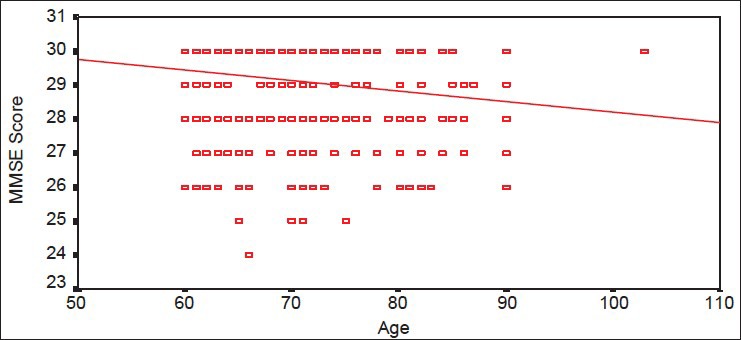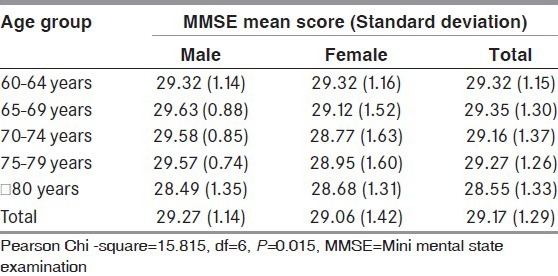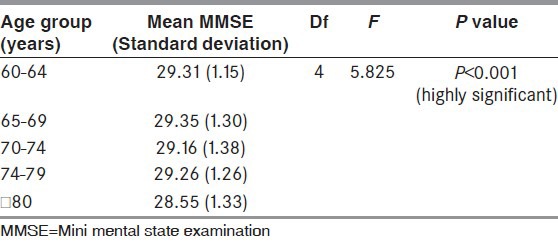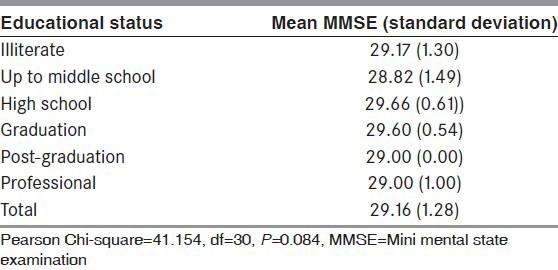Abstract
Introduction:
Studies have suggested that dementia is differentially distributed across populations with a lower prevalence in developing regions than the developed ones. A comparison in the prevalence of dementia across populations may provide an insight into its risk factors. Keeping this in view, a study was planned to evaluate the prevalence of dementia in tribal elderly population.
Materials and Methods:
A cross-sectional comprehensive two-phase survey of all residents aged 60 years and older was conducted. Phase one involved screening of all individuals aged 60 and above with the help of a cognitive screen specifically developed for the tribal population. Phase two involved clinical examination of individuals who were suspected of dementia as per the developed cognitive screening test.
Results:
The results revealed that no individual above 60 years of age in the studied population was diagnosed as a case of dementia. Thereby, pointing out at some unknown factors, which are responsible for prevention of dementia.
Discussion:
The differences between the prevalence rate in this study and other studies in India appear to be a function of a valid regional difference. Environmental, phenotypic and genetic factors may contribute to regional and racial variations in dementia. Societies living in isolated hilly and tribal areas seem less predisposed to dementia, particularly age related neurodegenerative and vascular dementia, which are the most common causes for dementia in elderly. This may be because some environmental risk factors are much less prevalent in these settings.
Key Words: Dementia, populations, risk, tribal
Introduction
Demographic aging is a global phenomenon. According to the 2001 census, India was home to more than 76 million people aged 60 years and above.[1] This age group, currently comprising only 7.5% of the population,[2] is expected to grow dramatically in the next few decades. It is estimated that there are already approximately 1.5 million people affected by dementia in India and this number is likely to increase by 300% in the next four decades.[3]
Several community-based urban and rural studies on dementia from different parts of India have documented rates varying from 1.02% to 3.36% above 60-65 years of age.[4,5,6,7,8,9] These rates are lower in comparison with a higher prevalence of dementia in developed countries, which ranges between 5% and 10% after 60-65 years of age.[10] All these studies reflect on the prevalence of dementia in urban and rural populations.
Extensive Pub Med search did not yield any reports on the prevalence of dementia among tribal elderly in India. This study was conducted in tribal elderly population of Himachal Pradesh with the aim of generating a hypothesis on differential distribution of dementia. The study was conducted among five Panchayat (village government) areas of Bharmour, tribal region covering a population of 12,003 individuals in the sub-Himalayan state of Himachal Pradesh in north-west India.
Materials and Methods
Study area
Bharmour is spread over an area of approximately 1,818 sq. km. and is one of the notified tribal areas in Chamba district of the northwestern part of Himachal Pradesh (India). It has mountainous topography having an altitudinal variation ranging between 1,350 m to 5,935 m above mean sea level. It is one of the less developed regions in the state of Himachal Pradesh because of very unfavorable climate (peculiarly cold and dry), poor geographical accessibility and lack of basic infrastructural facilities.
Study population
Bharmour is mainly inhabited by the Gaddi (nomads) community.[11] Gaddis are transhumant agro-pastoralists who combine the seasonal movement of livestock with seasonal cultivation.
Transhumant agro-pastoralism is the seasonal migration of livestock and humans from one agro-ecological zone to the other and back, from an established permanent home base. Mobility is the key to transhumant pastoral systems, enabling herders to move their livestock at different points in time, exploring ecological niches provided by microclimates at different agro-ecological zones, efficiently utilizing available resources, averting risks and producing food from land with no opportunity costs. The main crops grown in Bharmour are wheat, barley, maize and phulan.[12] The majority of elderly individuals in this community has had no formal education and is illiterate.[13]
We first developed a screening instrument for this largely illiterate, tribal population. The idea was to have a screening instrument, which was not dependent on the level of literacy. The population sample for the purpose of this study was 12,003 spread over five panchayats of tribal Bharmour.
Instrument development
Initial work-up
An expert group comprising of one bilingual investigator, two public health specialists, one internist and a psychiatrist from Himachal Pradesh developed a cognitive screening test for the population under study based on the English version of mini mental state Examination (MMSE) (including the similar general cognitive domains). The expert group sat together and worked on the possible alternatives to the English version of MMSE. An effort was made to arrive at consensus in development of the questionnaire and questions were accepted for inclusion, if all the expert group members gave their consent. The details of the expert group are provided somewhere else.[14]
Pre-pilot and questionnaire layout
The pre-pilot work centered on information-gathering on the suitability of the questionnaire developed. For this purpose, we sat down with 25 subjects of age 60 years and above and went through the questions together to identify potential problems in the applicability of the new version of MMSE on the Bharmouri cohort. After a pre-piloting session, we amended the questionnaire before piloting with another group of 25 testers. The amended version was again based on a unanimous decision by the expert group. This process was aimed at arriving at a scale wherein questions were unambiguous, appropriate and acceptable to respondents. We also tested the layout at this stage to ensure that field investigator could navigate his way easily through the questionnaire. In this way, we arrived at a Bharmouri version of MMSE (hereafter referred to as Bharmour Mental State Examination), suitable for use in tribal Bharmour.
Using the same iterative process (as was used for development of cognitive scale), a functional ability scale, in the questionnaire form (everyday abilities scale for India) for administration to the subject and a family member was developed for selected populations. It included items related to older adults’ routine activities in typical Indian settings.
Pilot phase
After the appropriate modifications were made to the test items, an age-stratified (60-64, 65-69, 70-74, 75+) random sample of 50 non-demented subjects (as indicated clinically) was drawn from the Bharmour census database for a pilot study. The clinical diagnosis was made by a psychiatrist and an internist. The subjects for the pilot phase were selected by simple random technique. Field worker administered the cognitive battery (BMSE) which was finalized at the end of the pre-test phase, to the subjects after obtaining informed consent and basic demographic information. The mean score obtained on BMSE on these 50 individuals was 28.77 + 1.04.
Each subject was assessed individually using the modified version of MMSE. The minimum time taken for assessing a single individual was 30 min. The assessment included a brief on the purpose of this study and its prospective outcome. No one refused to participate in the pilot study.
Screening
The study was a cross-sectional comprehensive two-phase survey of all residents aged 60 years and older. A house to house survey was conducted to identify individuals eligible for inclusion in the study. All eligible individuals present in their homes on the day of survey and who gave their consent to participate were included in the study. In this way, a total of 500 individuals were identified for the purpose of this study. The cognitive screen (BMSE) was administered by a trained investigator to all 500 individuals of age 60 years or above at their residence.
The participants who scored below 24 (out of a possible score of 30 on BMSE) were considered to be suspected cases of dementia and were evaluated for clinical diagnosis.
Informed written consents were taken from the participants and the interviews were conducted in their homes. Next of kin was asked to provide written agreement in the event of lack of capacity to consent.
Further 10% of individuals who were categorized as not having dementia on the basis of cognitive screening test were also evaluated clinically. The selection of 10% non-demented individuals for clinical evaluation was similar to the process carried out for the purpose of screening as it was for the presence of dementia. A house to house survey was carried out for this and every 10th elderly individual was included for clinical evaluation.
Clinical evaluation and diagnosis
The clinical evaluation was carried out by a psychiatrist with the help of an internist and two public health specialists.
The clinical assessment of dementia involved a careful detailed clinical history to determine the precise features of intellectual loss if any. The subjects were examined for three categories of symptoms: (1) cognitive or intellectual, (2) functional and (3) psychiatric or behavioral. An individual was confirmed as a case of dementia only after clinical evaluation. The clinical evaluation also included the use of cognitive screen scores (BMSE). The clinical team scored individuals on BMSE in a similar manner as was done by the field investigator. Wherever a difference in the scores between field investigator and clinical team was noticed; the score by the clinical team was taken as final.
Results
The demographic detail of the study population has been provided in Table 1. The population sample contained almost equal participants of both sexes. The highest number of the participants belonged to the age group 60-64 years resulting in 35.6% (178/500) of the total sample. This incidentally happens to be the youngest of the age groups studied. 15.6% (78/500) of the population studied was 80 years or more in age. No individual more than 60 years of age in the population studied scored less than 24 on the cognitive screen [Figure 1]. On clinical evaluation of 10%categorized as non-demented, no individual turned out to be a case of dementia. Table 2 reveals data on the mean cognitive scores according to the sex of the individual. No significant difference in cognitive scores was found between males and females. The mean score on cognitive screen was lowest for the age group of 80 and above [Table 3]. The mean score for this age group was 28.55 ± 1.33.
Table 1.
Demographic details of the study population

Figure 1.

A scatter plot for cognitive screen score versus age
Table 2.
Cognitive screen scores for males and females

Table 3.
Cognitive screen sores for different age groups

An analysis of cognitive scores between different age groups reveals significantly lower scores for the age group 80 years and above [Table 3]. Education does not seem to influence cognitive screen scores much as varying trends can be observed with the increase in educational status [Table 4].
Table 4.
Cognitive screen sores according to educational status of the study population

Discussion
Population comparisons showing a difference in dementia prevalence opens an area for its potential prevention. This also leads to an understanding of potential risk factors associated with it. In 2005, Alzheimer's disease International commissioned an international group of experts to review all available data and to reach a consensus on dementia in 14 World Health Organization regions.[15] The results from that review suggested that 24.2 million people live with dementia world-wide, with 4.6 million new cases every year.[3] The trend towards a lower prevalence in less developed regions than in developed settings was endorsed, at least for sub-Saharan Africa and South Asia.[15] However, the data on dementia from the least developed areas of the less developed regions of sub-Saharan Africa and South Asia is not available. The present study based in a tribal area of north-west India aims at understanding the prevalence of dementia in least developed areas. It thereby attempts to generate a hypothesis on potential risk factors based on differential distribution of dementia across populations. The study, being based in a tribal illiterate population needed a cognitive screen, which was independent of educational status of the study population. The results of this study perhaps also report on the robustness of the scale used in this study.
With demographic ageing proceeding rapidly in all regions world-wide, interest began to focus on the previously neglected topic of dementia in low-income and middle-income countries (LMIC).[15] Perhaps this interest in differential distribution arouse out of curiosity to outline the risk factors for dementia. This probably may also have been because, two-thirds of all people aged 65 years and older and a similar proportion of people with dementia were living in LMIC, with a rapid increase predicted.[16] However, two studies funded by the National Institute of Ageing from that period-the US-Nigeria study[17] and the Indo-US study[9] suggested an age-specific prevalence of dementia that was only between a quarter and a fifth of that typically recorded in developed countries. Prevalence and incidence of Alzheimer's disease (AD) seems to be much lower in some developing regions like India. Community-based urban and rural studies on dementia from different parts of India have documented variation in rates.[4,5,6,7,8,9,10] In 2007 and 2008, a study conducted on ethnic Kashmiris (Kashmiri Pandits) settled in Jammu District of J and K, after their migration from Kashmir in 1990 in the wake of militancy related conflict in Kashmir region of J and K revealed dementia in a substantial number of the migrant Kashmiri Pandits.[18,19] On the contrary, dementia appeared to be very rare in the native Kashmiri population as per an earlier study conducted in 1986 in Kashmir valley before the start of militancy related conflict.[20] Prevalence in dementia among tribals, in our study is almost similar to the prevalence of dementia in Kashmir valley reported in the above mentioned study.
A growing body of the epidemiological literature suggests that lower levels of education are associated with higher prevalence of dementia and lack of education may be a risk factor for AD.[3] If there is a genuine difference in risk, one would expect to find a higher prevalence rates of AD in societies with lower educational levels, perhaps in pandemic proportions in populations with no formal education. The present study points to the contrary.
The study therefore suggests that, the differences between the prevalence rates for dementia across populations appear to be a function of a valid regional difference. Environmental, phenotypic and genetic factors may contribute to regional and racial variations of dementia. Studies as the one mentioned above suggest that societies living in isolated hilly and tribal areas seem less pre-disposed to dementia particularly age related neurodegenerative and vascular dementia which are the commonest causes for dementia in elderly. This may be because some environmental risk factors are much less prevalent in these settings.
What accounts for dementia being rare in tribal population? A healthy social engagement, absence of stress associated with social disengagement, more so among the elderly in urban settings, differences in lifestyle particularly the physical activity, phenotypic attributes; dietary factors may be some of the factors preventing dementia. The presence of variety of foods like barley, wheat, maize and phulan as staple foods in comparison of largely wheat and rice dependent populations in rural and urban India may also be a factor. Further consumption of apples and walnuts (rich in antioxidants) may also be helpful. A parallel in this regard can be drawn with the Kashmir valley study conducted in Kuthar area of Kashmir.[20] The food habits of that population are almost similar to that of this population with an abundance of apples and walnuts. Also, the fact that populations living in isolation/tribal area/high altitude have lower prevalence of hypertension, diabetes, dyslipidemia, obesity; all identified as midlife risk factors for dementia, may be helping them prevent the development of dementia.[21]
Impact of age as a non-modifiable risk factor for dementia is also evident in this study as is apparent by the declining scores on the cognitive scale as the age advances. This assumes importance as studies in India have found that dementia is often not recognized as an illness but is construed as part of normal aging.[22]
In spite of care to be methodologically accurate, we may have missed on some individuals suffering from cognitive impairment. This could be because of a relatively smaller sample studied. Also, the fact that the study was carried on tribal transhumant agro-pastoralists, wherein a caregiver is more likely than not to carry a patient of dementia with him and therefore may not be found at Bharmour. A larger study sample than the one used in this study may have been useful in providing us with a better understanding on the prevalence of dementia in tribal elderly.
Conclusions
This study opens up areas in research for developing and understanding of risk factors for dementia. The potential for identifying hitherto unidentified risk factors and potential primary prevention arise because (a) there are population differences in dementia prevalence (b) difference in trends among different populations within same nations with some population reporting dementia as a rare phenomenon.
Prevention and early intervention is the foundation for public health approach to preventing complications due to dementia. The identification of potential risk factors also has implications for clinical management of these potential risk factors as part of secondary prevention in managing dementia.
Footnotes
Source of Support: Nil
Conflict of Interest: Nil
References
- 1.Sathyanarayana Rao TS, Shaji KS. Demographic aging: Implications for mental health. Indian J Psychiatry. 2007;49:78–80. doi: 10.4103/0019-5545.33251. [DOI] [PMC free article] [PubMed] [Google Scholar]
- 2.New Delhi: Office of the Registrar General and Census Commissioner India, Ministry of Home Affairs; 2012. Govt. of India. Sample Registration System Statistical Report 2010, Report No. 1 of 2012. [Google Scholar]
- 3.Ferri CP, Prince M, Brayne C, Brodaty H, Fratiglioni L, Ganguli M, et al. Global prevalence of dementia: A Delphi consensus study. Lancet. 2005;366:2112–7. doi: 10.1016/S0140-6736(05)67889-0. [DOI] [PMC free article] [PubMed] [Google Scholar]
- 4.Shaji S, Promodu K, Abraham T, Roy KJ, Verghese A. An epidemiological study of dementia in a rural community in Kerala, India. Br J Psychiatry. 1996;168:745–9. doi: 10.1192/bjp.168.6.745. [DOI] [PubMed] [Google Scholar]
- 5.Bharucha NE, Bharucha EP, Bharucha AE, Bhise AV, Schoenberg BS. Prevalence of Parkinson's disease in the Parsi community of Bombay, India. Arch Neurol. 1988;45:1321–3. doi: 10.1001/archneur.1988.00520360039008. [DOI] [PubMed] [Google Scholar]
- 6.Rajkumar S, Kumar S, Thara R. Prevalence of dementia in a rural setting: A report from India. Int J Geriatr Psychiatry. 1997;12:702–7. doi: 10.1002/(sici)1099-1166(199707)12:7<702::aid-gps489>3.0.co;2-h. [DOI] [PubMed] [Google Scholar]
- 7.Rajkumar S, Kumar S. Prevalence of dementia in the community: A rural-urban comparison from Madras, India. Aust J Aging. 1996;15:9–13. [Google Scholar]
- 8.Shaji S, Bose S, Verghese A. Prevalence of dementia in an urban population in Kerala, India. Br J Psychiatry. 2005;186:136–40. doi: 10.1192/bjp.186.2.136. [DOI] [PubMed] [Google Scholar]
- 9.Chandra V, Ganguli M, Pandav R, Johnston J, Belle S, DeKosky ST. Prevalence of Alzheimer's disease and other dementias in rural India: The Indo-US study. Neurology. 1998;51:1000–8. doi: 10.1212/wnl.51.4.1000. [DOI] [PubMed] [Google Scholar]
- 10.Canadian study of health and aging: Study methods and prevalence of dementia. CMAJ. 1994;150:899–913. [PMC free article] [PubMed] [Google Scholar]
- 11.Himachal Pradesh- Census of India website. [Last accessed on 2012 Sep 15]. Available from: http://www.censusindia.gov.in .
- 12.Bhasin V. Gaddis’ folk medicine: A source of healing. Ethnomedicine. 2008;2:1–27. [Google Scholar]
- 13.Tribal areas- Government of Himachal Pradesh. [Last accessed on 2012 Sep 15]. Available from: http://www.himachal.nic.in/tribal/tribalarea.htm .
- 14.Raina SK, Raina S, Chander V, Grover A, Singh S, Bhardwaj A. Development of a cognitive screening instrument for tribal elderly population of Himalayan region in Northern India. J Neurosci Rural Pract. 2013;4:147–53. doi: 10.4103/0976-3147.112744. [DOI] [PMC free article] [PubMed] [Google Scholar]
- 15.Llibre Rodriguez JJ, Ferri CP, Acosta D, Guerra M, Huang Y, Jacob KS, et al. Prevalence of dementia in Latin America, India, and China: A population-based cross-sectional survey. Lancet. 2008;372:464–74. doi: 10.1016/S0140-6736(08)61002-8. [DOI] [PMC free article] [PubMed] [Google Scholar]
- 16.Prince M. The need for research on dementia in developing countries. Trop Med Int Health. 1997;2:993–1000. doi: 10.1046/j.1365-3156.1997.d01-156.x. [DOI] [PubMed] [Google Scholar]
- 17.Hendrie HC, Osuntokun BO, Hall KS, Ogunniyi AO, Hui SL, Unverzagt FW, et al. Prevalence of Alzheimer's disease and dementia in two communities: Nigerian Africans and African Americans. Am J Psychiatry. 1995;152:1485–92. doi: 10.1176/ajp.152.10.1485. [DOI] [PubMed] [Google Scholar]
- 18.Raina S, Razdan S, Pandita KK, Raina S. Prevalence of dementia among Kashmiri migrants. Ann Indian Acad Neurol. 2008;11:106–8. doi: 10.4103/0972-2327.41878. [DOI] [PMC free article] [PubMed] [Google Scholar]
- 19.Raina SK, Pandita KK, Razdan S. Incidence of dementia in a Kashmiri migrant population. Ann Indian Acad Neurol. 2009;12:154–6. doi: 10.4103/0972-2327.56313. [DOI] [PMC free article] [PubMed] [Google Scholar]
- 20.Razdan S, Kaul RL, Motta A, Kaul S, Bhatt RK. Prevalence and pattern of major neurological disorders in rural Kashmir (India) in 1986. Neuroepidemiology. 1994;13:113–9. doi: 10.1159/000110368. [DOI] [PubMed] [Google Scholar]
- 21.de León AC, Pérez Mdel C, González DA, Díaz BB, Coello SD, Hernández AG, et al. Hemodynamics and metabolism at low versus moderate altitudes. High Alt Med Biol. 2011;12:179–86. doi: 10.1089/ham.2010.1078. [DOI] [PubMed] [Google Scholar]
- 22.Patel V, Prince M. Ageing and mental health in a developing country: Who cares? Qualitative studies from Goa, India. Psychol Med. 2001;31:29–38. doi: 10.1017/s0033291799003098. 22. [DOI] [PubMed] [Google Scholar]


